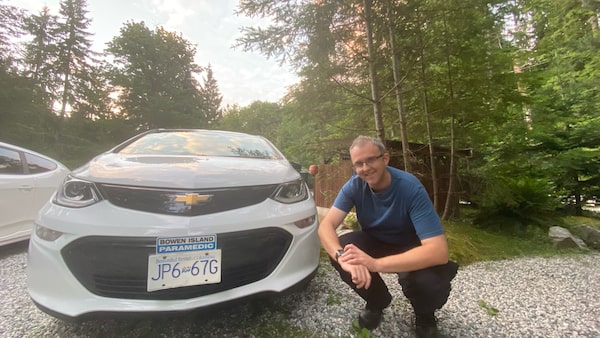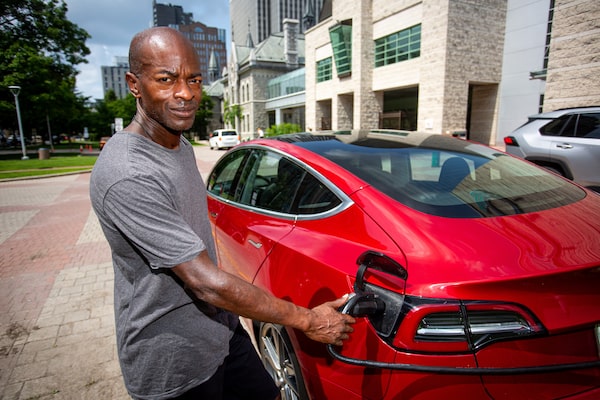This article was written and edited before Krystyna Lagowski passed away in October, 2023. She was a valued member of the Globe Drive team, contributing regularly since 2022 on topics including electric vehicles, charging infrastructure, car buyer protection and dealer regulation.
Electric vehicle ownership rates are on the rise in Canada, but most of those making the switch from gas-powered cars are people with driveways.
In fact, a recent survey by PlugShare and the Canadian Automobile Association showed 77 per cent of people with EVs or plug-in hybrids live in single-detached homes.
For those living in apartments and multi-unit buildings – about six million Canadians – the idea of charging an EV is much more challenging.
Challenging, but not impossible, says Harry Constantine.
Mr. Constantine rents a ground-floor basement suite in a house in Port Moody, B.C., and had planned to charge his 2019 Chevrolet Bolt EV for free while at work. But the pandemic began three weeks after he bought it, and he began working from home.

Harry Constantine, who rents an apartment in Port Moody, B.C., uses a collection of apps to find public charging points.
It didn’t take long for Mr. Constantine to figure out the public charging network with PlugShare, a free charger-locating app.
“You take a look at Vancouver on PlugShare, adjust the chargers that are applicable to your EV, and you can barely see the city,” he said, explaining that there are plenty from which to choose. Whenever he goes out to run an errand, he’ll plug in while stocking up on groceries or picking up other essentials. “I graze when it comes to charging.”
Mr. Constantine, who is presently a paramedic, estimates he usually pays about $20 a month for charging and drives about 20,000 kilometres a year. He uses a collection of apps – PlugShare, ChargePoint, BC Hydro, Flo and Electrify Canada – to find charging spots. To compare, it would cost about $220 a month to fuel a Honda Civic if it were driven the same amount and gas cost $1.90 a litre, which is about the average price in that area.
Right now, he has zero regrets about buying the Bolt. As a bonus, Mr. Constantine notes that he often scores better parking, because chargers are usually located near store entrances. In fact, he thinks it’s silly to visit a gas station to pump gas. “I can do much better things with my time,” he said.
For all Canadians to be able to charge their cars after gas-powered cars are phased out in the next few decades, it’s clear the public charging infrastructure needs improvement – and fast.
According to Leslie Ng, a sustainability specialist for the City of Vancouver, there are about 300 public charging points in the city. Currently, the city is working on a neighbourhood charging strategy to identify more public charging sites in neighbourhoods, places of worship or underused parking lots.
“We want to install some infrastructure and support charging that’s closer to home,” she said. “Our aim is for every resident to be within a 10-minute drive of a charger.”

Ottawa Tesla owner Lawrence Williams says he spends only $10 a year on charging his electric car, after scouting free charging stations throughout the city.Andrew Meade/Andrew Meade
When Lawrence Williams bought his 2018 Tesla Model 3 in November, 2018, he qualified for a promotion that gave him free charging for the lifetime of the car at any Tesla Supercharger station.
At first, he was plugging it in to the 120-volt electric outlet on the bollard at his Ottawa condo’s parking spot; Teslas get about three to five kilometres of charge per hour on those kinds of outlets.
But at winter’s end, he said the condo board would no longer allow him to charge there and shut off the power. The board also denied his proposal to install a couple of EV chargers for the whole building.
“They said it drew too much current and risked tripping the entire block,” said Mr. Williams, who works for the Department of National Defence.
He turned to public chargers. Despite Tesla’s reputation of a robust charging network, Mr. Williams had to drive 25 kilometres to find the nearest Tesla Supercharger. Luckily, he soon found a free Level 2 charger at a local mall. However, he had to leave by 7 p.m., when the garage closed.
Eventually, he found another free local Level 2 charger at the International Brotherhood of Electrical Workers company. “It’s available to the public but they don’t want anyone charging for more than two hours,” said Mr. Williams. “Some people would just leave their cars there all day long.”
Mr. Williams estimates that he drives about 17,000 kilometres a year, and uses the free PlugShare EV locator app, as well as Swtch and Hydro-Québec’s Electric Circuit/Circuit électrique charging network apps. His resourcefulness has served him well: he said he’s figured out ways to keep his car charged for about $10 a year.
Swtch has a roaming deal with Electric Circuit, as well as ChargeHub (another EV charger locator app) so that EV owners with these apps can use all the partner networks, giving them access to thousands of chargers across the country.
“It doesn’t make sense to stick to one network,” said Thomas Martin, director of business development at Swtch. He believes that EV drivers are going to use a station that’s close to home or along their route.
“There’s not much emphasis on price,” said Mr. Martin. “Location and convenience are the primary factor for attracting drivers.”
Even without home charging, EV owners are finding clever ways to make the most of the public EV charging network while saving money in the process. As Mr. Williams and Mr. Constantine can vouch, taking advantage of timing and good deals can make the wait for public chargers a little less painful for apartment dwellers.
Editor’s note: An earlier version of this story stated Swtch has a roaming deal with Flo. In fact, they do not. This version has been corrected.